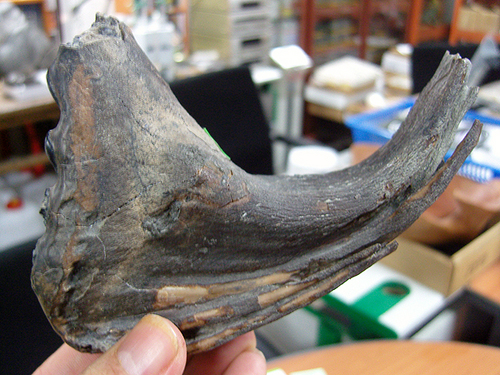일반명 : 암모스어금니(Woolly mammoth teeth)
지질시대 :후기프라이스토세(late Pleistocene)
last European Ice Age(200,000 - 20,000 years ago)
학명 : Mammuthus primigenius
원산지 : Yuribei River on the Gyda Penisula, NW Siberia, Russia.
The woolly mammoth (Mammuthus primigenius), also called the tundra mammoth, is an extinct species of mammoth. This animal is known from bones and frozen carcasses from northern North America and northern Eurasia with the best preserved carcasses in Siberia.
This mammoth species was first recorded in (possibly 150,000 years old) deposits of the second last glaciation in Eurasia. They were derived from steppe mammoths (Mammuthus trogontherii).
It disappeared from most of its range at the end of the pleistocene, however on Wrangel Island a breed of dwarf woolly mammoth survived until roughly 1,700 B.C
Woolly mammoths had a number of adaptations to the cold, most famously the thick layer of shaggy hair, up to 50 cm (20in) long, for which the woolly mammoth is named. They also had far smaller ears than modern elephants; the largest mammoth ear found so far was only a foot (30 cm) long, compared to six feet (1.8 m) for an African elephant. They had a flap of hairy skin which covered the anus, keeping out the cold.[citation needed]
Their teeth were also adapted to their diet of coarse tundra grasses, with more plates and a higher crown than their southern relatives. Their skin was no thicker than that of present-day elephants, but unlike elephants they had numerous sebaceous glands in their skin which secreted greasy fat into their hair, improving its insulating qualities. They had a layer of fat up to 8 cm (3 in) thick under the skin which, like the blubber of whales, helped to keep them warm.
Reconstruction












































 수량을 선택해주세요.
수량을 선택해주세요.





































